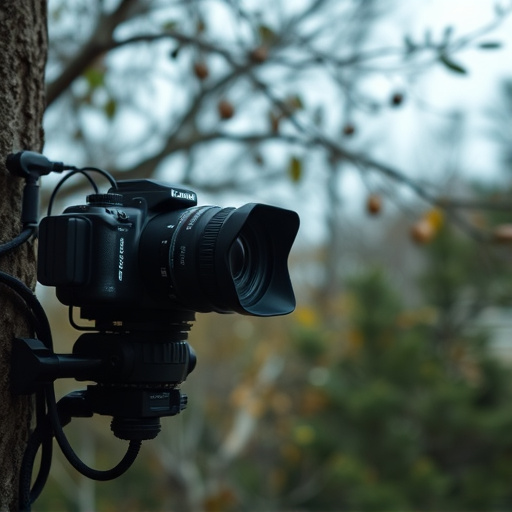Electromagnetic signal scanning is a non-invasive method to detect small hidden cameras in nurseries, ensuring privacy and safety for children. By identifying unique signal patterns, this technology revolutionizes surveillance, fostering trust while adhering to privacy laws regarding covert recording devices.
Uncover the unseen with our comprehensive guide to hidden lens electromagnetic signal scanning. Explore the intricate world of electromagnetic signals, learning how to scan for their subtle traces—a crucial step in identifying small hidden cameras in nursery settings. Discover non-invasive detection techniques, legal privacy boundaries, and advanced tools tailored for this sensitive task. Stay informed and protect your space from these covert devices.
- Understanding Electromagnetic Signals and Their Scanning
- Uncovering Hidden Cameras in Nursery Settings
- Techniques for Non-Invasive Signal Detection
- Legal Considerations: Privacy and Surveillance
- Advanced Tools for Locating Small Hidden Cameras
Understanding Electromagnetic Signals and Their Scanning
Electromagnetic signals are an integral part of our daily lives, often going unnoticed yet playing a crucial role in various technologies. These signals are created by the movement and manipulation of electric charges, resulting in a range of frequencies from radio waves to gamma rays. Understanding these signals is essential when it comes to scanning for hidden cameras, especially in sensitive areas like nurseries.
In the context of small hidden cameras for nursery monitoring, electromagnetic signal scanning offers a discrete and advanced method of detection. By analyzing the unique patterns and emissions of these signals, specialized equipment can identify the presence of covert recording devices. This non-invasive technique allows parents and caregivers to ensure privacy while keeping an eye on their little ones without the need for visible surveillance equipment, providing peace of mind in a safe and secure environment.
Uncovering Hidden Cameras in Nursery Settings
In today’s digital era, ensuring privacy and safety in nursery settings has become paramount. Uncovering hidden cameras is a critical aspect of this process, as small hidden cameras for nursery environments can be subtle yet pervasive. Parents and caregivers must remain vigilant to protect young children. These tiny devices, often disguised as everyday objects like toys or books, can capture sensitive information without the knowledge of adults.
Regular checks and the use of specialized equipment, such as electromagnetic signal scanning guides, are effective ways to detect these hidden cameras. By understanding how to navigate this digital landscape, nursery staff can create a secure space for children to learn and play. This proactive approach not only safeguards privacy but also instills confidence in parents, knowing their children are in capable and cautious hands.
Techniques for Non-Invasive Signal Detection
Non-invasive signal detection techniques play a crucial role in the safe and effective utilization of small hidden cameras, especially in sensitive environments like nurseries. These methods allow for monitoring and surveillance without causing disruption or harm to the subject being observed. One such technique involves electromagnetic field (EMF) scanning, which can detect signals emitted by tiny hidden cameras, providing an alternative to visible light-based detection methods.
EMF sensors are particularly useful in identifying the presence of small hidden cameras, as these devices often operate on radio frequencies or emit EMF radiation as byproducts of their electronic components. By employing specialized equipment and analyzing the electromagnetic signals, professionals can locate and track these hidden cameras, ensuring privacy and safety in nursery settings and other sensitive locations.
Legal Considerations: Privacy and Surveillance
When employing small hidden cameras, such as those suitable for a nursery setting, legal considerations around privacy and surveillance become paramount. The use of covert surveillance equipment raises ethical and legal questions, especially regarding consent and the potential invasion of personal space. In many jurisdictions, there are strict regulations governing the installation and use of hidden cameras to protect individual privacy rights.
For instance, laws may dictate that clear and visible notification must be given when monitoring private areas like a nursery, ensuring individuals are aware they are being recorded. The placement of small hidden cameras for surveillance purposes should adhere to these legal boundaries, balancing security needs with the right to privacy. Parents or caregivers installing such devices should thoroughly understand their local laws and ensure compliance to avoid potential legal repercussions.
Advanced Tools for Locating Small Hidden Cameras
In today’s digital age, ensuring privacy and security has become a paramount concern, especially in sensitive areas like nurseries. This is where advanced tools for locating small hidden cameras play a pivotal role. With the right equipment, such as electromagnetic signal scanning devices, parents or caregivers can rest assured that their children’s private moments are safe from prying eyes. These innovative tools are designed to detect even the tiniest of hidden cameras, offering peace of mind in what can be a challenging and sensitive issue.
When it comes to small hidden cameras for nursery settings, electromagnetic signal scanners prove to be game-changers. They utilize specialized technology to identify invisible signals emitted by these clandestine devices, allowing users to uncover potential threats lurking in the most unexpected places. By employing such advanced techniques, caregivers can create a secure environment, fostering trust and tranquility in their nurturing spaces.
The hidden lens electromagnetic signal scanning guide highlights advanced techniques for detecting small hidden cameras in nursery settings, addressing a critical concern for privacy and safety. By understanding electromagnetic signals, navigating legal boundaries, and utilizing innovative tools, parents and caregivers can ensure secure environments for children. This comprehensive approach empowers individuals to protect their privacy while fostering a sense of security in today’s digital era.
